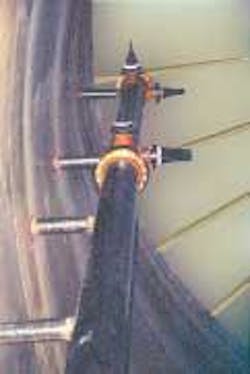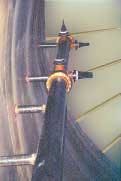Valving System Designed to Prevent Tank Stagnation
Pittsburgh, Pa.-based Red Valve Co. has developed a reservoir mixing system that uses its patented Tideflex® duckbill diffuser technology.
The Tideflex Mixing System consists of a single pipe manifold and two sets of duckbill diffuser valves. Standard diffuser valves are mounted to one end of the pipe for tank filling, and inline diffuser valves are installed inside the opposite end of the pipe for tank draining. Each system is custom designed to accommodate any tank.
Duckbill diffuser valves operate on the differential hydraulic pressure that is already in place in the tank's fill-and-drain process, so no external energy source is required. The variable orifice design creates a restriction at the point of discharge, increasing jet velocity and further improving mixing within the tank. The valves are constructed of NSF 61 approved elastomers.
Case Study
After seeing an advertisement for the mixing system, the Hixson Utility District (HUD) in Hixson, TN, contacted Red Valve in January 2001 with the intention of including the system in the upgrade of its 1 million gallon standpipe. One month later, HUD had placed the order, and construction was underway on this fast-paced project.
The standpipe contains one protrusion that was being used as a common inlet and outlet, and water flows in and out of the tank at a virtually constant rate.
"We had very little fluctuation in the tank level and practically no turnover," said HUD's Tom Bockman. "Our chlorine residuals weren't a serious problem, but state limits are getting tougher. This was a proactive approach."
According to Bockman, HUD has been searching for a solution to its turnover situation for nearly four years, during which time staff had explored several options. They considered a second protrusion in the tank, but this would have required the utility to run a huge piping loop around an existing building and uproot an entire treatment plant, among other inconveniences.
"With all the additions, including all the extra piping inside the tank, it would have been a lot more expensive," Bockman said.
To ensure the best mixing in HUD's 56-foot-high tank, Red Valve designed a system with two sets of three eight-inch fill valves set 10-feet apart on a vertical riser pipe. Tall tanks are prone to slight level fluctuations, and water discharging from non-submerged valves cannot achieve maximum jet velocity. With two sets of valves, the lower set is likely to be always under water, while the higher set still protects against any possibility of short-circuiting at the top of the tank.
Red Valve recognized and addressed another situation before it could become a problem for HUD. Two 16-inch drain valves are installed on a horizontal pipe close to the bottom of the tank. Process equipment at the bottom of such a tall standpipe absorbs a great deal of backpressure, especially at full volume.
To have the valves handle this amount of backpressure alone, Red Valve would have had to construct them with thicker bills, which would have increased headloss and decreased draining efficiency. Instead, the company recommended its Saddle Support Technology, a metal accessory installed at the opening of the valve that can more than double maximum backpressure capacity.

